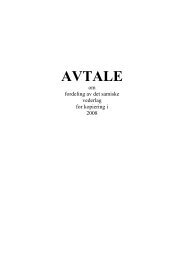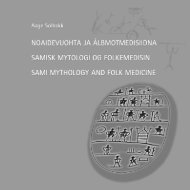Duodji - hvem eier kunnskapen og verkene?
Duodji - hvem eier kunnskapen og verkene?
Duodji - hvem eier kunnskapen og verkene?
You also want an ePaper? Increase the reach of your titles
YUMPU automatically turns print PDFs into web optimized ePapers that Google loves.
Dovddus govvadáiddár Nils Nilsson Skum lei maiddái duojár. Su<br />
niibehápmi lea mihtilmas, ja son geavaha buorremealgadii seamma<br />
govvosiid (motiivvaid) su čoarvedujiin go su govain. Dán niibbi ja<br />
dohpa lea duddjon 1939. Niibi ja dohppa lea priváhta oamastusas.<br />
Kniv av den kjente billedkunstneren Nils Nilsson Skum.<br />
Knife by the famous artist Nils Nilsson Skum.<br />
© Gunvor Guttorm.<br />
as we see with knife handles and sheaths.<br />
The large antler sheaths that have been<br />
preserved in museums and that the Samis<br />
still produce today show that when people<br />
started making these sheaths, it became a<br />
challenge to utilise the material such that<br />
there was as little waste as possible and<br />
a good shape on the sheath. Sheaths that<br />
are preserved in museums document that<br />
large antler sheaths were quite common<br />
when the Samis started making sheaths<br />
from reindeer antlers (cf. Guttorm, 1993).<br />
For these sheaths, it has not always been<br />
necessary to have large antlers to begin<br />
with; it was possible to put two smaller<br />
antlers t<strong>og</strong>ether. Both the sheath and shape<br />
of the shaft have changed, such that other<br />
duodji has also changed. These shapes of<br />
the sheaths are often regarded as Sami knife<br />
and sheath shapes, and in today’s terms, we<br />
could almost say that the Sami knives and<br />
sheaths have become trademarks.<br />
Gradually as these shapes of sheaths have become<br />
familiar and popular, other craftsmen<br />
have also discovered these shapes. But the<br />
Samis have never had a “monopoly” on the<br />
shapes, even though we can often read in<br />
books that the shape of the knife sheath is a<br />
Sami shape, or is called a “lappkniv” (Lapp<br />
knife) (in Sweden), “finnkniv” (Finn knife)<br />
(in Norway) or “samekniv” (Sami knife).<br />
Or can a group apply for design protection<br />
on the sheath since it is known as Sami?<br />
Komse (Sami cradle)<br />
Komsa (definite form of komse) is a good<br />
example of duodji that has also long been in<br />
use amongst the Samis. Its form and working<br />
method have been tested and adapted<br />
to a nomadic lifestyle (cf. Guttorm, 1991).<br />
Gradually as this understanding of komsa<br />
has ended up in the background, new values<br />
have arisen. Thus, komsa we see today does<br />
77




